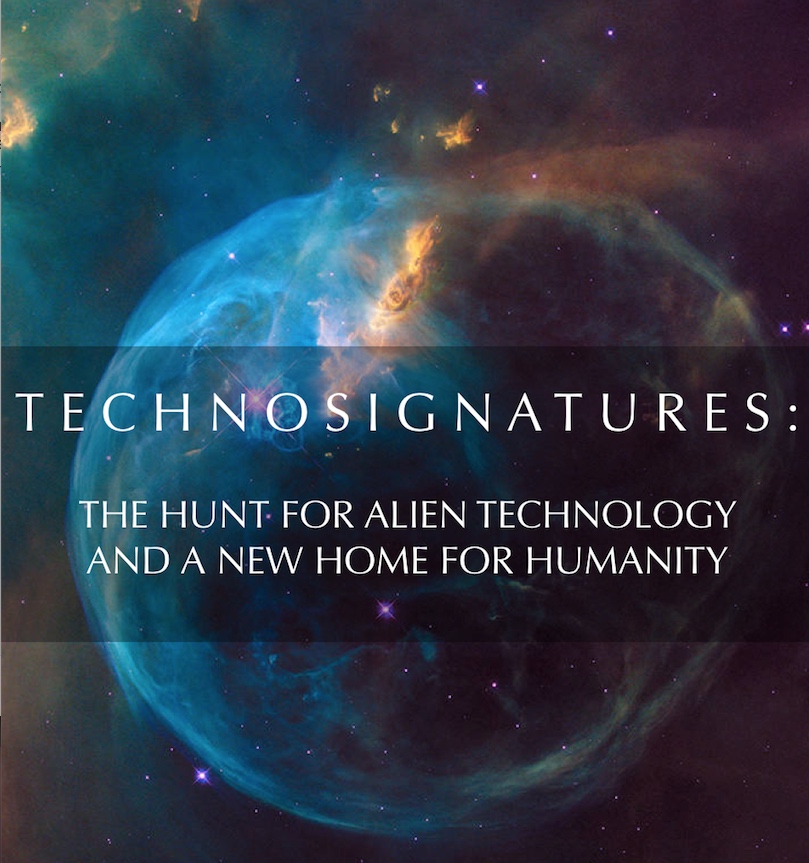A major shift has happened in the search for extraterrestrial technologies. For decades scientists at S E T I (Search for Extraterrestrial Intelligence) have been looking for evidence of someone else’s technology…radio signals…in all the wrong places. Then, on September 18, 2018, NASA hosted a conference dedicated to wrapping its head around the greater ET reality. NASA is now on the hunt for “technosignatures”, the flashy new term for the search for signs and signals of SUPER ADVANCED ALIEN TECHNOLOGIES.
Coined by former S E T I director and astrophysicist, Jill Tarter, “technosignatures” marks a dramatic expansion of the kind of technology we now think aliens possess.
Out are radio signals, in are everything from “porch light” laser lights that attract ETs (like the one recently proposed by MIT), to massive mega-structures like blast shields to protect from invaders, to Dyson spheres that harvest the energy of stars to AI.
We are now searching for it all…even in our own backyard.
The age of technosignatures is here.
CONGRESS IS IN…
The door to this new age was thrown open on April 13, 2018 when the US Government officially renewed, and doubled down, on its interest in extraterrestrials. And they introduced a titillating new word into the ancient alien vernacular to put an exclamation point on the questions they raised.
The last time the Congress bet on ET answering humanity’s call was way back then, in 1992, when Congress funded S E T I and the search for the Search For Extraterrestrial Intelligence.
Unfortunately, in 1993 the $60 million project was pulled when Nevada Senator Richard Ryan derided the effort as “Martian hunting season at the taxpayer’s expense” and all but ceded the race for first contact to China, who build the galaxy’s biggest radio dish to listen for a message from ET.
For 25 years Uncle Sam stayed out of the business of publicly searching for ETs.
NASA has focused on biosignatures, which include possible microbes on other solar system bodies or Earth-like planets orbiting other stars
Now, in this about face, lawmakers in the House of Representatives proposed legislation that would authorize “at least $10,000,000 for each of fiscal years 2018 and 2019 for the search for technosignatures … such as radio transmissions, in order to meet the NASA objective to search for life’s origin, evolution, distribution, and future in the universe.”
The technosignatures provision came from Lamar Smith, a now retired Republican congressman from Texas, who worked with S E T I to craft the language, according to S E T I researchers.
The House bill specifically directs NASA to “partner with the private sector and philanthropic organizations to the maximum extent practicable to search for technosignatures.”
This partnership has already begun. Paul Allen, the recently deceased Microsoft co-founder, donated $30 million to build the Allen Telescope Array, a collection of radio telescopes in California dedicated exclusively to S E T I observations, after Tarter asked him.
Yuri Milner, a Russian tech billionaire, is spending $100 million over a decade on S E T I research at several organizations.
TECHNOSIGNATURES. WHAT ARE THEY?
Simply, they are signs of super advanced technology on other planets developed by civilizations as evolved as we are to more highly evolved ones.
Some of these civilizations may be in the stars. As we will discuss, the Kepler Space Telescope has shown us our cosmic neighborhood is populated by numerous earth like planets that may be inhabited by civilizations as technologically ‘advanced’ as we are.
Other technosignature creating civilizations may have existed on earth in the distant past.
At least that is the contention of Penn State astrophysicist Dr. Jason T. Wright, who argues that we should be looking for ancient alien technosignatures on earth.
His highly evocative paper, “Prior Indigenous Technological Species”, was posted on the online research archive ArXiv on April 24, 2017 and notes the term technosignatures encompasses a range of possible artifacts, including archaeological ruins and old mining operations as well as synthetic chemicals or nuclear isotopes that could have been created only by technological processes. (The Atlantic probed this subject in an April 2018 article, “Was There a Civilization On Earth Before Humans?“)
Archaeology would reveal technosignatures less than a few tens of thousands of years old, he said.
The geological record of the past few hundred million years might show a distinct layer if the technology had a widespread geological effect, as ours does.
If the species were spacefaring there may be technological artifacts to be found throughout the Solar system. In this case, Wright says we should look below the surface of Mars.
Was there a civilization previous to Adam?
Myths from the ancient world, especially Egypt, tell us there was.
Wright proposes such a civilization may have vanished from earth due to a cataclysm, either natural or self-inflicted, or maybe some other means.
Given that space is so hard on the human body it is possible they were translated alive to another dimension.
Either way the discovery of an ‘elder’ race is one possibility for the techno signatures search.
THIS IS A H U G E DEVELOPMENT
What triggered the Congress to embark on a sudden and dramatic search for technosignatures?
Two things: Kepler Space Telescope data and Tabby’s star.
First Kepler.
Launched in 2009 and retired in 2018, NASA’s Kepler Space Telescope roamed deep space for nine years collecting data that revealed our sky to be filled with billions of hidden planets – more planets even than stars.
Its mission was to find earth-like planets in habitable zones (called Goldilocks zones) around nearby stars.
Its results are mind blowing.
Before Kepler’s launch in March 2009, no one new for sure just how many planets may be out there.
Today (November 14, 2018) there are 3837 confirmed exoplanets in our neighborhood.
Many of which could be promising places for life.
The most recent analysis of Kepler’s discoveries concludes that 20 to 50 percent of the stars visible in the night sky are likely to have small, possibly rocky, planets similar in size to Earth, and located within the habitable zone of their parent stars. That means they’re located at distances from their parent stars where liquid water – a vital ingredient to life as we know it – might pool on the planet surface.
Think about that.
The question of whether or not there are other habitable planets in the galaxy we could move to now seems almost as ‘old world’ as the conventional thinking of the1920s when astronomers knew there was only one galaxy, our Milky Way. Now, we know there are 100 billion and 200 billion galaxies in the observable universe…and counting. (The number will likely change when the James Webb Space Telescope launches in 2020.)
Thanks to Kepler we now we know we live in a universe teeming with galaxies and our own galaxy is teeming with planets.
Nearby our home are nearly 4,000 planets. One of them could be habitable by humans.
The explosion of knowledge of exoplanets, and the results of decades of research on biosignatures have encouraged NASA to address, in a scientifically rigorous way, whether humanity is alone.
Which brings us to Kepler’s other great discovery.
Tabby’s Star.
Discovered by a citizen scientist and named after astronomer Tabitha Boyajian, “Tabby’s Star” fired public imagination after Kepler picked up strange fluctuations in its brightness. These large dips were speculated to be caused by a Dyson Swarm, a hypothesized alien megastructure that surrounds a star and captures its light for energy.
Though only a few scientists took this theory seriously (enough), and scientists have since concluded that a dust cloud is the likely cause, Tabby’s Star has demonstrated the potential usefulness of looking for anomalies in data collected from space, as signs of technologically-advanced life may appear as aberrations from the norm.
Putting Kepler’s discoveries together with Tabby’s star someone in Congress did the math and woke up to the realization that our neighborhood is packed with planets… and they may be inhabited.
But that’s not the real reason they are looking.
The search for technosignatures is part of a larger program to solve the problem of ‘too many humans on earth creating too many problems’.
The writing is on the wall that it may soon be time for humanity to make a back up copy of our selves on another planet.
We are starting to bump up against the absolute true fact that Earth is finite,” Amazon founder Jeff Bezos said. He’s right. Our planet’s resources are finite.
But, it may be our destiny is in the stars. Bezos is one of the chief advocates for our migration into space.
The richest known person in the galaxy (with about $148 billion) told Wired, in a new article and at the magazine’s 25th Annual Wired Summit, that off-world habitats could house, “millions, billions, maybe even a trillion people.”
I am sure he has already given thought to the possibility that we will meet races in space who could be way ahead of us, and probably even way, way ahead of us, on the evolutionary spiral.
It may ending being the case that we won’t be searching for planets with technosignatures, but instead precious planets without them! That is, we are searching for another earth that isn’t already occupied.
Hopefully, we will help us find the right one.


Even those of us who do not have scientific credentials know that it’s pretty clear that unless we get off this planet ( almost 8billion now) we are not going to survive. If we know that and we do why have those who have these stellar degrees waited so long to do the obvious? As a lay person I’ve been listening, reading, going to conferences and traveling some for 30 years to get an on the ground sense of what’s in store for the human family. I’ve never seen a UFO or met an off planet entity, but I know, and have always known ( no convincing necessary ever! ) that we are not alone. It never occurred to me that Earth was the only place to be.
Finally, …. perhaps in my current lifetime …. I’m a senior …..Dr Cherry Muhanji
I think William’s work is a technosignature right here in earth!! The earth might be finite..but what about the light body?? Could the light body be a technosignature?? Could the light body be used to detect technosignature? I would say a large craft manned by some type of intelligence, from another star system, targeted towards earth as a planet killer,the REAL KILLSHOT, sent purposely to destroy earth..is one heck of a technosignature!!
i think the last time the Congress bet on ET answering humanity that call was way to back them. this is unbelievable that in 1993 the 60$ millions project was pulled when Nevada Senator Richard Ryan decide to build.